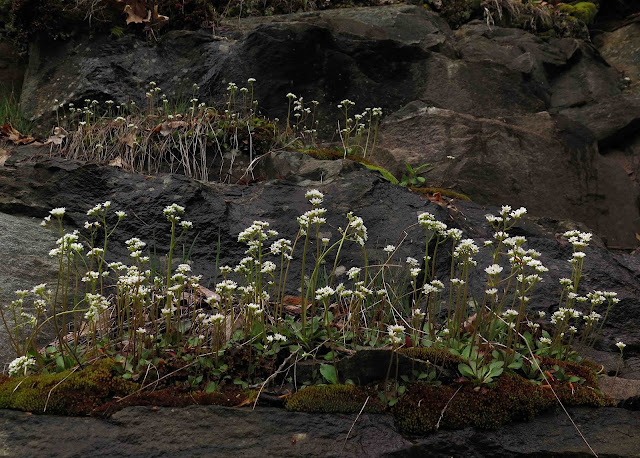Rain, rain, rain! It stops for a minute, just long enough for me to get my waterproof boots on, and then it starts again. Actually, I don't mind walking in the rain for a bit, but my camera doesn't like getting wet. So what can I do to feed my nature addiction? Aha! I'll go for a drive. Maybe park somewhere where I can dash back to my car if a downpour approaches. And I'll bet it's time to check out the roadside rock gardens along Spier Falls Road. So off I went.
Sure enough, as I approached the first rocky ledges that steeply rise from the edge of Spier Falls Road as the road follows the Hudson River, I could see masses of small white flowers crowding the tops of the jagged rocks.
Oh yes, masses and masses of a single species called Early Saxifrage (Micranthes virginiensis) covered the ledges so thickly, I doubted any other other flower could gain a foothold.
A closer look at these drifts of white flowers revealed a definite wildflower monoculture.
While there may not be any other herbaceous wildflower that intrudes on these masses of saxifrage, there sure are other plants of another kind that add their beauty to these dark spring-watered rocks. I did not see a single plant of Early Saxifrage that was not growing out of a clump of moss. I believe the mosses act like sponges to hold the spring water dripping down the rocks, and this would keep the roots of the saxifrage from drying out on this otherwise bare exposed rock.
And what a marvelous mix of mosses thrive on these constantly watered rocks! I know the names of very few mosses, but I have been told that the aptly named Fountain Moss (Philonotis fontana) thrives here. And perhaps the starry-leaved moss is a species of Haircap (Polytrichum sp.), but I'm not sure. Some brown-colored fern-like mosses (Thuidium?) are poking up through both of the other mosses.
I do know the name of this fluffy-leaved moss with the perfectly spherical spore capsules. It's called Apple Moss (Bartramia pomiformis). I bet those apple-shaped spore capsules played a role in creating its name!
Oh wait! I did find one other flower besides Early Saxifrage on these rocks, but this one is a shrub, not a herbaceous plant. It's called Round-leaved Gooseberry (Ribes rotundifolium), and its flowers can be distinguished from other species of gooseberry flowers by the stamens extending far below the sepals.
I continued on down the road a ways, stopping to observe a waterfall tumble down the mountainside, flush from all the recent rain.
The sun emerged briefly from behind the clouds, causing the waterfall's droplets to sparkle and also to illuminate a lovely patch of Early Saxifrage thriving atop a creekside boulder.
It was time to head home, but as I passed a parking area at the Spring Trailhead leading up to the Palmertown Mountains, I noticed a shrub off in the woods that was layered with huge clusters of snowy-white flowers. So I parked to investigate these blooms and found a Hobblebush (Viburnum lantanoides) heavy with bloom. As these big white encircling sterile flowers worked to catch my eye, that's also what they're intended to do to pollinators, drawing them in to feed on the much smaller, less showy fertile florets clustered in the middle. Only a few of the fertile flowers had opened as yet.

Glancing around, I noticed another flowering tree, a small one abloom with white flowers. Drawing close, I noticed clusters of blooms with rounded petals, each flower containing a single stamen surrounded by many pistils. That single stamen signaled a stone fruit, probably a cherry of some kind (since I noticed a tiny red gland at the base of a leaf). But which cherry? Checking my Newcomb's Wildflower Guide (one of the few wildflower guides that include flowering trees), I read that Prunus pensylvanica has white flowers in small umbels that grow along reddish twigs, with clusters of leaves growing at the ends of flowering branches. Seemed like a match! But which vernacular name should I use: Bird, Fire, or Pin Cherry? I think I'll go with Fire Cherry, to remind me of those red twigs. Also, this species of cherry is known to quickly colonize burned-over areas. Newcomb didn't mention this cherry was fragrant, but it certainly was!

Nearby was yet another flowering woody shrub, and I didn't need my Newcomb's to look it up, I've seen it so often. These creamy-white twin flower clusters and compound leaves virtually shout RED-BERRIED ELDER (Sambucus racemosa) at me.
Across the trail from that elderberry shrub is a patch of Foamflower (Tiarella stolonifera) I visit every spring, such a lovely, crowding-together bunch of flowers it is, the flowers most elegantly silhouetted against the deep shade of the background forest. It was lovely even now, although still in bud.
And just up the trail, crowded masses of tiny Azure Bluets (
Houstonia caerulea) were raising their lovely faces to the sky, almost as if they were mirroring the sky's blue radiance in the grass. Even if, as was true today, the sky was very gray!
Walking back to my car, I decided to cross the road to a wooded area along the Hudson, remembering that Painted Trilliums (Trillium undulatum) sometimes bloomed there. I was doubtful, thinking it way too early to look for this species of trillium. But this was my lucky day!

















No comments:
Post a Comment